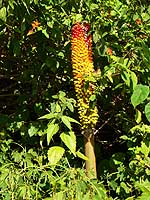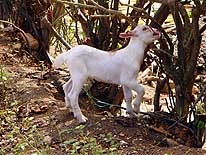| Home
News
Overview
Diary
Statistics
In Deutsch
MAIL

|
Enjoy some pictures, taken in Timor-Leste - Part 2:
Mainland
Part 1: Exclave of
Oecussi
-
-
-
|
-
-
- Taiwan Map
|
-
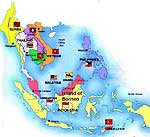
-
-
-
-
-
-
- Map of Southeast Asia
-
|

|
- click a picture to see details
- the colored numbers of the pictures are corresponding with
the map of the above mentioned link in the same color
|

|
-
-
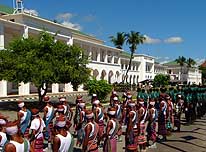
|
-
-
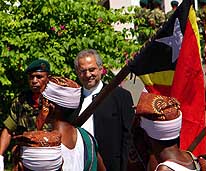
|
-
40
Poster for the second presidential
- elections of May 9th, 2007 – the second
- ballot between José Ramos-Horta and Francisco
- Guterres, alias Lu Olo, of the Fretilin-Party
|
- Celebration of the 5th Independence Day and the simultaneous Inauguration of the newly
- elected President José Ramos-Horta on May 20th, 2007 at the Government Palace in Dili
|
-
41
The Guard of Honor is ready .....
|
-
42
..... President José Ramos-Horta
- greets the Guard of Honor
|
-
- Timor-Leste – "the Eastern Frontier of Asia"
– "Mainland with Dili" (Part
2)
-
-
- Music from the ship’s loudspeaker awakes us ungently from our restless sleep.
Outside it is still pitch-black night. Only the brilliantly lit port of the capital Dili
gleams from the distance. One hour later – it slowly starts to dawn – we are
berthing. From one minute to the other, it becomes hectic: The passengers squeeze all at
the same time towards the exit, fully loaded with their bulky luggage. Emil sits already
in front of his steering wheel and waits patiently for the orders of the ships crew to
disembark. Abruptly they arrive from all sides with a lot of confusion and shouting
“go!, go!, go!”, as if there would be suddenly a great rush. Carefully, we drive
to the ramp and realize that due to the high tide the angle to the quay is very steep.
More cautiously, we maneuver across some ropes and mats, but the car chokes – we
speed up and hear, still a bit drowsy, a terrible bang. Both of us rush out of the car.
What we see is alarming: Our low-lying 60 gallon gasoline tank was violently hit on its
left back corner by a protruding hook of the ramp and is leaking: a thin but steadily flow
of gasoline! We shouldn’t have let us rush by all this yelling, but should rather
have waited in the hull for the tide to recede to have the ramp’s angle declined! We
panic and take the first item that we find trying to seal it temporarily: Our earplugs
made of wax, what of course doesn’t help at all. Desperately, Emil gets the hammer
and tries to seal the hole by bending the metal. And he really succeeds to stop the
leaking almost. Now it is only dripping slightly. We cannot and don’t want to remain
in the port. Thus we leave it by the gate and approach the first early morning jogger in
sight to ask for directions to the Backpackers hostel. It seems to be close and easy to
get there, besides that we have to pass the refugee camp of the IDP’s
(“internally dislocated people”) who are responsible once in a while for the
violence and troubles in the city. Luckily, in this early morning hours, it is still
completely peaceful.
|
-
-
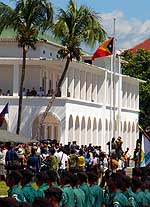
|
-
-
-
-
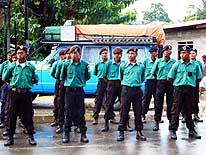
|
-
-
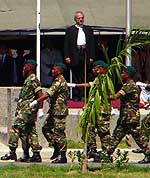
|
-
43
Hoisting the flag at the Independence
- and Inauguration Celebrations of
- May 20th, 2007 in Dili
|
-
44
All are training for the parade
- on the eve of the celebrations
|
-
45
The Military is parading in front
- of the newly elected President José
- Ramos-Horta, who was awarded
- the Nobel Peace Prize in 1996
|
-
- Behind the protecting high walls of the Backpackers, we feel safe and relaxed. Rita, the
lady-boss, is still asleep and has to be woken up by her staff. She appears with a dozy
face and shows us the only available room. It has air-condition, an attached bathroom with
hot shower and toilet, even a small kitchen with a gas stove and refrigerator. Compared
with Indonesia, the price is a shocking US$25 a night, but still seems to be the cheapest
in Dili. Even one bed in her dormitory costs US$10. We have been warned that Timor-Leste
with the US-Dollar being the official currency is an expensive place. But still we think
the prices in the Backpackers are exaggerated, considering that we have to sleep with the
nightly noise of the bar and its music blaring with full power until sometimes in the
early morning hours. Well, we inevitably survived. After we have settled down, Emil
continues with the difficult task of sealing the gasoline tank properly. He looks through
our “goodies box” for the two-component epoxy, only to realize that the paste
has dried out. The unbelievable good luck is that Henry, Rita’s Australian partner,
stores two big cans of a gasoline resistant epoxy in his small workshop, which we may use
and what seems to work. Day by day, we continuously put a layer to the broken part until
the trickle ends completely. What remains and what we have to live with is some moisture.
In the beginning, we are a bit worried whether this actually improvised sealing will
withstand the coming heavily potholed and corrugated roads. As time passes by, we
seemingly can relax – the patch up lasts!
|
-
-
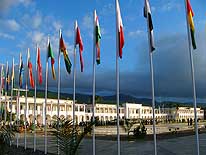
|
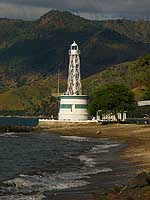
|
-
-
-
-
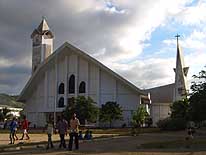
|
-
46
The Government Palace in Dili is
- beautifully flagged for the Independence
- and Inauguration Celebrations
|
-
47
Dili’s Farol light tower
- adorns the long city promenade
|
-
48
In front of the “Cathedral of
- the Immaculate Conception”, children
- of the refugee camps (called IDP’s /=
- internally displaced people) are playing
|
-
- In the afternoon, we are already moving around busy Dili, firstly to the Internet that
costs a hefty $6 per hour, then to Timor-Telecom, where we buy a $20 SIM-card for our cell
phone. Afterwards, we enjoy exploring the well stocked shelves of the three main
supermarkets. The major assortment comes from Australia – even Foster beer is not
missing. But everything is expensive. As already seen before in Africa and other third
world development countries, it seems to be a fact that expatriates don’t like to
loose their living standard from back home. Though in “Landmark” we discover
also inexpensive stuff: 2 pounds frozen pork filet for $4, a whole frozen chicken for
$3.70, ½ pint of full cream for 80 Cents and one pound of pasta for $1.20 –
instantly, tomorrow’s menu is born! In “our” kitchen in the Backpackers we
prepare pork filet on a creamy mushroom sauce, pasta and salad – a real treat for a
very special day: The celebration of the Independence Day of Timor-Leste.
|
-
-
-
-
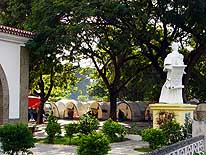 -
|
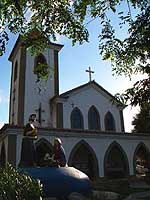
|
-
-
-
-
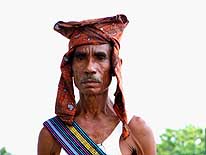 -
|
-
49
The IDP’s have also found shelter in
- tents on the compound of the “Cathedral
- of the Immaculate Conception” in Dili
|
-
50
The Jesus crib at the Motael
- Church in Dili attracts its attention.
- This church houses also an IDP camp
|
-
51
A village chief in his traditional
- outfit is posing for a picture
|
-
- The lines of spectators who gather for the ceremony of the 5th Independence Day and the
simultaneously inauguration of the newly elected President on May 20th, are already dense,
when we arrive at the festively flagged Government Palace. But they gladly squeeze
together to allow us foreigners also a good view in the front row, at the end of the
already positioned guard of honors. We are not one minute too early. Shortly after our
arrival, earlier President Xanana Gusmão and his family arrive in a black car. Then, the
festivities start and José Ramos-Horta, who received the 1996 Nobel Price for Peace, is
saluting the guard of honor in the scorching heat of the midday sun. For a short moment,
we are merely ten feet away from him and are astonished how little precautions for his
security have been taken, at least visible ones. Besides the omnipresent,
indistinguishable UN vehicles that are moving around and are parked all over the place,
everything seems to look normally. We have heard that there are UN-observers, respectively
– advisors and troops from 46 different nations trying to help to pave Timor’s
rocky road to democracy. We are also amazed and also a bit saddened to see how emotionless
and how reserved the people behave. Even when José Ramos Horta holds his doubtlessly
promising inaugural speech, there is hardly anybody applauding. In less than an hour, the
show is over. No incidences have occurred so far, everything was quiet. Later, however, we
hear that at one of the hot spots, violence has taken place between two rivaling gangs
with the disturbing result of one dead and seven burnt houses.
|
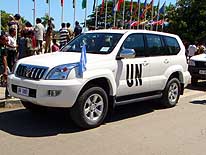
|
-
-
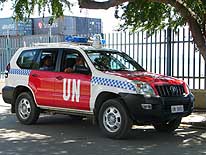
|
-
-
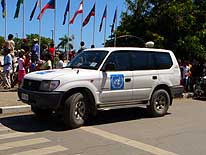
|
|
52 |
53 |
54 |
- In the capital, the presence of UN vehicles is everywhere. Apparently, there are
observers and troops from 46 different nations here.
- Apart from all kinds of UN vehicles, scores of NGO cars can also be seen circulating
(Non Government Organizations)
|
-
- Next morning, we head first of all to the Indonesian Consulate to apply for a new
two-month visa, because we know from different sources that it can take up to seven days
to be issued. Therefore, we are more than pleased to read on the information board in the
waiting room that it will be now ready within three days, although a little more pricey
than before. And we are even more pleased to hear from the friendly lady at the counter
that we can collect it already after tomorrow. During the waiting time, we visit the Arte
Moris Gallery, managed by our compatriot Luca Gansser and his German wife Gaby. Luca is on
the brink to leave for Switzerland for an interview with the Ticino television about his
work. Nevertheless, he takes time for us. He tells us that he founded this “Free Art
School” five years ago, as he got stuck here during his travels. Today, he shelters
30 talented young people who work together with him and whom he educates. But after the
bloody unrests in May 2006, there were 500 “internally displaced people” who
sought refuge in his compound. Today, still 200 are living here despite that it would be
safe for them to return to their villages. He also shows us two thatched houses on the
flat roof – built in the traditional style – that serve as workshops for the
artists, their library, living room and – being self-sustaining – their
vegetable gardens too. We end up in the exhibition hall admiring the many inspiring
artworks. We cannot stop to esteem people who – with a lot of initiative and
determination – invest all their efforts and energy into a remote, not very promising
country, in order to help less privileged people. Luca and Gaby certainly are a fine
example.
|
-
-
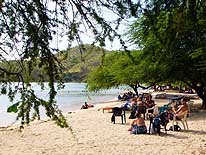
|
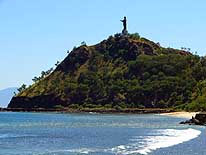
|
-
-
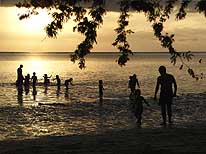
|
-
55
The Areia Branca beach near
- the statue of Christo Rei in Dili is
- the Sunday gathering place of the
- UN’s and NGO’s
|
-
56
The statue of Christo Rei at Cape
- Fatucama – a replica of the one in Rio
- de Janeiro. It has been erected during
- the Indonesian occupation, is 27 meters
- (89ft) high and symbolizes the
- 27 provinces of Indonesia (back then
- including East Timor)
|
-
57
Children as well as adults
- enjoy the sunset at the beach
- of Areia Branca
|
-
- But we also keep admiring those optimists who invest their “good money” into
unsettled nations like Timor-Leste, providing work for the local people and hold out even
when others get cold feet and fly out. Ann and Wayne belong definitively to this kind of
people. We meet them coincidentally in the Backpackers Bar, after we didn’t find them
in their dive shop called “The Freeflow Diving Center”, where we wanted to thank
them for their valuable emailed information and tips about the security situation. They
contributed essentially to our decision to take the risk and visit this beautiful country.
Also today, they are once more of a great support: Spontaneously, Wayne adds our hand
phone number to his UN warn net system. Luckily, Telekomsel Indonesia has sponsored us
recently this cell phone, and already one hour later we receive an SMS detailing, which
parts of town should be avoided. Although the outbreaks of violence and troubles occur
usually in the late afternoon or evening hours while we aren’t anymore on the
streets, we feel good to get informed. In our three weeks’ stay in Timor-Leste, we
enjoy many more hours and beers in Ann and Wayne’s company. Their great knowledge and
enthusiastic pictures they paint of this land of which we knew very little before,
reinforce our desire to explore as much as possible of it. And when they show and lend us
out the beautiful picture book „Timor-Leste, Land of Discovery“ from Daniel J.
Groshong, we can hardly wait to take off.
|

|
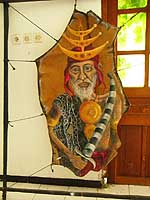
|
-
-
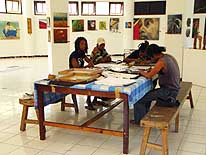
|
-
58
The Arte Moris Gallery is the work
- of Swiss citizen Luca Gansser and his
- German wife Gaby. At the time being,
- it shelters 30 free artists, many coming
- from the IDP community
|
-
59
One of the many impressive
- works in the exhibition room .....
|
-
60
..... Artists working on new images
|
-
- Finally, with our gasoline tank full of Indonesian fuel, – which is b.t.w.
available at $ 3.33 a gallon in comparison to $4.05 for the Australian stuff – our
beer and food supplies stocked up and our emails checked, we set out under a blue sky with
much anticipation to discover new land on the same day we received our new Indonesian
visa. From the very moment we branch inland from the “Areia Branca”-Beach –
2½ miles East of town – we enjoy magnificent views at every turn. For a short time,
a truck convoy with supplies for the hinterland, escorted by UN police, is driving in
front of us, but then, we lose sight of it. The narrow road meanders through an
undeveloped, beautiful and unspoiled landscape, passing untouched beaches, mangrove swamps
and rolling hills covered with yellow, high grass. Again and again we stop to take
pictures. Therefore, we reach the “Bob’s Rock” Dive Site at km 45 –
one of the sites in Timor-Leste where the underwater world is said to be still mostly
intact (unfortunately we are not diving, but have seen magnificent pictures of it!) –
where Wayne is leading a group of divers early afternoon. The timing is just right for the
picnic. Quickly, we put out table and chairs under a shady tree and enjoy a lovely time in
good company. Strengthened with a big piece of birthday cake that Ann has been baking at
home for one of the divers, we all hit the road hours later: The divers back to Dili and
we in opposite direction towards the unknown.
|
-
-
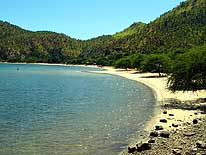
|
-
-
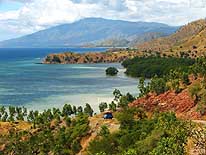
|
-
-
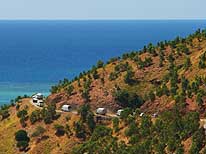
|
-
61
The lovely bay with the Areia Branca
- beach near Dili is deserted during the week
|
-
62
We left Dili and are driving
- eastwards, where a beautifully
- and diverse coast is uncovering
|
-
63
UN vehicles are escorting
- an IMO convoy to the East
|
-
- The further we continue east, the less traffic there is. We discover many sandy tracks
leading through the bushes towards the sea. The sun is already low on the horizon, when
between Manatuto and Laleia we decide to follow one of these vague tracks hoping to find a
place to set up our camp. We end up at an open space under a huge tree directly on the
sandy beach. On three sides, rolling hills, covered with yellow and reddish high grass,
scattered thorny acacias and green eucalyptus trees surround us. In the warm rays of the
evening sun, they gloom like pure gold. Up in the skies, white bizarre clouds looking like
huge mushrooms keep forming, the setting sun casting magnificent colors on them –
from pink to yellow, from yellow to orange and then changing into flaming red. And far out
in the ocean, a thunderstorm forms a pitch-black wall. It is just magnificent. Sitting on
our camping chairs, we enjoy the tropical night until late, and when we finally are ready
to sleep, it is still hot in our car. As so far no mosquitoes have bothered us, we
optimistically leave the rear door open, for which we have no net because it’s
normally closed. But very soon we regret it deeply. With the decreasing of the evening
breeze, these beasts arrive, not single, but in crowds and spoil us the second part of our
so romantically started first camping night in Timor-Leste. We should also have paid more
attention to the loud splashing of the waves, being so close to the shore. That sound
starts slowly to get on our nerves too. But as it usually goes: We were so overwhelmed by
this lovely spot that we simply switched off all our normal senses!
|
-
-
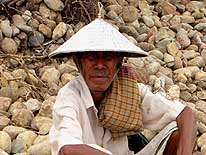
|
-
-
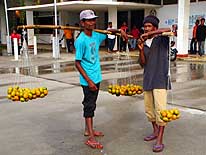
|
-
-
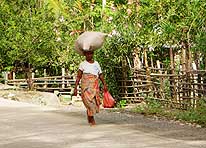
|
-
64
A goat herdsman is watching
- his roaming animals
|
-
65
Two mandarin vendors gossip in
- Dili. 8 mandarins cost one US$
|
-
66
People carrying heavy loads on their
- head is not an unusual sight in Timor-Leste
|
-
- „Gecko, gecko, gecko ..... “ We are very excited to hear at dawn the call of a
gecko – a rather plain looking lizard of approximately 4 inches long – from a
bent tree right across our camp. But unfortunately, we cannot make it out in the dense
bush. Since our relaxed time in the “Villa Bruno” in Sanur on the island of Bali, where one of them lived in the timber-work of
“our” house, we have become very fond of its undistinguishable call, today nine
times in a row, what seems to be a good sign. There is a saying that the frequency
determines the luck (in Bali it once succeeded eleven times). But our fortune stays within
the limits – at least regarding the weather pattern – as we continue to move
eastwards. Already in the next village, in Laleia with its twin-towered Portuguese church
in pastel pink colors on a hill overlooking the river, the skies darken dramatically. Now
and then still a ray of sun is peaking through, as we follow the river valley with carpets
of rice fields stretching out on both sides of the road. In Vemasse however, a settlement
of some modest huts, a Portuguese ruin and a deteriorating church, it starts to rain.
|
-
-
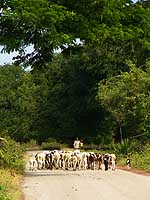
|
-
-
-
-
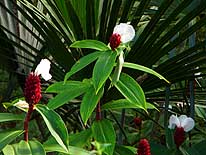
|
-
-
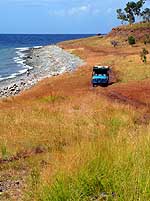
|
-
67
Herds of goats seizing the
- entire road is also an everyday
- sight in the country side
|
-
68
An exotic flower reveals its beauty
|
-
69
The track ends, but the spot
- is not recommendable for camping
- as it is visible from the road
|
-
- From there, the road climbs up and winds its way to Baucau, the second largest city in
Timor-Leste, passing some simple thatched houses, sometimes surrounded with beautiful
multicolored bougainvilleas. Plenty bundles of wood are for sale along the road – as
if there wasn’t already enough logging done. But everybody tries to earn some money
to survive somehow. When we reach Baucau, lying on an altitude of 1’000 ft., it is
pouring. The market place that serves also as bus station looks chaotic with all its
scattered garbage and dirty puddles. However the lower lying old quarter, lined with
Portuguese colonial buildings, spreads a peaceful atmosphere. The absolute masterpiece is
the abandoned “Mercado Municipal”, which is badly in need of a restoration. But
even in its decaying condition, it looks still very charming. Shortly afterwards we are
back in the plains with the rice paddies. We cross villages with names like Laga and
Lautem, where we do not feel really comfortable as youngsters yell after us in a rather
aggressive tone – the more East we drive, the more we are entering the stronghold of
Fretilin. Therefore, we are glad when there are less people towards Com – the end of
the Eastern road. Two miles before the “end of the island of Timor”, we discover
a meadow along the seashore with dilapidated pavilions, a beach with white sand, acacia
trees providing shade and not one person. Spontaneously we decide to pitch up our second
night camp here, hidden from the road. We count three more cars driving by; afterwards,
there is absolute silence.
|
-
-
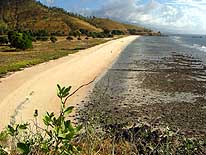
|
-
-
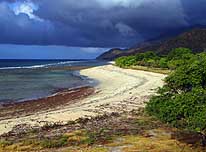
|
-
-
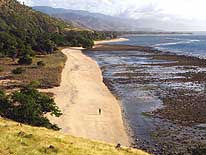
|
- Deserted beaches at no end:
|
-
70
The "Dollar Beach" .....
|
-
71
..... the Black Rock Beach .....
|
-
72
..... and other pristine beaches
|
-
- Com seems rather uninteresting to us. It exists only of a row of corrugated iron huts,
the expensive “Com Beach Resort” with some air-conditioned rooms in containers
and two simple bungalows, all facing the road. But the drive was still worth due to the
scenic landscape. Additionally, we see our first traditional sacred house in Fataluku
style, with the floor raised up on stilts and a high tapered roof, decorated with a big
nautilus- and strings of small cowry-shells. Despite all the warnings that the road is
supposed to be extremely bad, Emil wants to try the shortcut over the mountains to Los
Palos in the Southern hinterland. The start is surprisingly good until we reach a long
stretched village of straw huts where it deteriorates drastically and where the children
are not very friendly. Soon we reach a lovely plateau with green grass, volcanic stones
and yellow-reddish conical flowers. It is a beautiful spot, which we have all for
ourselves, enjoying the silence and solitude. Shortly after, the “sealed”, but
heavily potholed road changes abruptly into a stony, badly rutted and sloping track.
What’s now? There are only nine miles left to Los Palos – but they could become
very long. Shall we take the risk? After a careful inspection, our decision is negative.
The risk of tipping over with our heavy roof load is far too big, despite of the fact that
this strain could be too much for our old-timer. On our way back, we stop at the village
and – to the big amazement of the watching villagers – refill our jerry can with
water from the public tap for our next shower, before we return to the coast. Being only a
stone’s throw from our last night’s camp, why not spend our lunch break there?
However, it doesn’t work out the relaxed way as we would have liked it: Several heavy
downpours make the cooking pretty difficult, and also checking the brakes – what Emil
insists he has to do now – gets many wet interruptions. Being still early in the
afternoon, we decide to continue until Los Palos, but this time on the smooth main road
that branches off at Lantem, the village we do not really like.
|
-
-
|
|
-
-
|
-
73
Two water buffaloes take
- their young in the middle
|
-
74
Between the scattered volcanic
- stones on the plateau towards Los Palos,
- we discover this unique flower
|
-
75
A baby goat is nibbling at a bare
- stalk, despite that the greenery is every-
- where after the end of the rainy season
|
-
- Like Baucau, Los Palos is welcoming us with heavy rain too. The revolutionary wall
paintings, the T-shirts with Che Guevara motifs of the youngsters, and the Fretilin flags,
which blow in the strong wind and slightly differ from the official Timor-Leste flag,
prove that we are in a stronghold of the oppositional Fretilin party, which has its
powerful base in the East. Our plan to drive from here to Tutuala in the extreme East
disappears pretty fast as we see the appalling road conditions. This isn’t fun
anymore! As there is no more new land to explore in the East, our return to Dili is
imminent. Because there is only one practicable road along the North coast, the way back
is the same as we came – the Southern track is impossible and impassable with a car
due to broken bridges and frequent landslides. At least, at our turning point, we are able
to enjoy traditional twin Fataluku houses on the roadside, where small children from the
neighborhood are quickly present to pose for a picture in front of them– of course
with a lot of fuss, but nevertheless a nice souvenir.
|
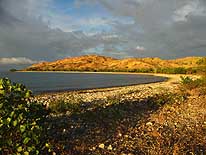
|
-
-
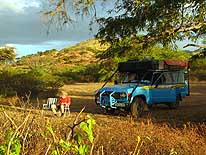
|
-
-
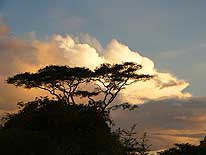
|
-
76
At this lonely beach between
- Manatuto and Laleia we find
- a beautiful and lonely spot to camp
|
-
77
We enjoy our surroundings in
- the warm light of the evening sun .....
|
-
78
..... and the ever changing
- magnificent clouds
|
-
- Meanwhile, it is mid-afternoon. Confident to find easily another nice campsite on a
beach, we push on. But this time, it does not work out and we have to consider sleeping in
Baucau, what means driving into the darkness – not necessarily what we are looking
forward to. Because the later the evening, the more critical it gets to cross the
villages, when big crowds of youngsters gather on the street, sometimes just looking for
troubles. On a narrow bridge right outside of Laga it happens: We run into angry fighting
between two groups where we have to go through, there is no alternative. Afraid, that they
might throw rocks at us (rock-throwing is a specialty in Timor-Leste), we press all the
way through as fast as possible and are more than relieved when we reach the other end
unharmed. Usually, the trouble-makers are not after tourists, but if one is coincidentally
caught in between, they might not care much. When we climb up the steep hill towards
Baucau, it is already night. We are really lucky that two days ago we spotted the sign of
the guesthouse “Casa Coures” on a small side road and that Emil, thanks to his
excellent sense for orientation, finds it also in the darkness. The only town hotel, the
expensive “Pousada de Baucau”, is out of reach for our budget. Our guesthouse is
very basic though: A tiny room with two bunk beds, a wall that doesn’t go right up to
the ceiling, a shared washroom where there is not enough water ..... Nevertheless, we are
happy to have a roof over our heads and that our LandCruiser is safely parked in the
compound.
|
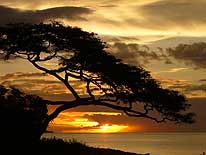
|
-
-
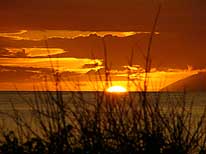
|
-
-
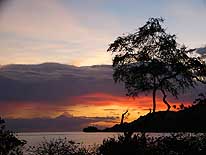
|
-
79
|
-
80
|
-
81
..... and the sunrise
- is not less beautiful
|
- Today’s glow of the sunset is especially dramatic .....
|
-
- Early morning, we are definitely on our way back to Dili, being only 76 miles from
Baucau. Again, we marvel at the magnificent scenery, Timor-Leste has to offer, even if
it’s the second time. About halfway, we reach Manatuto, a coastal village looking
deserted in the scorching tropical midday heat. High up on a hill, we notice a pavilion.
Being time for our lunch break, we ascend it straightforward on the narrow and steep path,
and arriving on the top we cannot believe our eyes how beautiful the panorama is: In the
West the rugged coastline, in the East the lush rice paddies and in the South the
scattered hills – and we have it completely to ourselves! In the shade of the
pavilion that shelters a statue of a Saint, we enjoy our picnic and a cold beer out of our
12-volt refrigerator. The goats whose piles of little droppings are omnipresent – the
most to be found on the cool steps leading to the statue – are nowhere to see. Dili
is now less than two hours drive away. But we have absolutely no desire to spend already
the coming night in the noisy and expensive Backpackers hostel. Therefore, we keep our
eyes open all along the coast for a nice spot to set up camp. At the “Black
Rock” Beach, 23 miles before the notorious capital, we like it. But as fishermen keep
coming along, we move on – just as a precaution. Only 7½ miles short of Dili, we
feel safe and are not visible from the road. We pitch up the camp under acacia trees right
on a sandy beach with plenty of cowry shells. It is low tide. Some women still look for
crabs and other edible sea creatures along the exposed reef, but with the setting sun,
they also disappear.
|
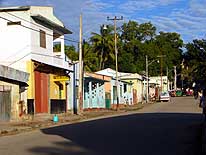
|
-
-
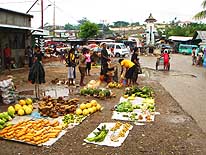
|
-
-
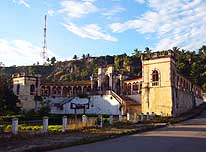
|
-
82
The colonial street front in the old
- part of the town of Baucau, the second
- largest town in Timor-Leste, is still a
- heritage of the Portuguese reign
|
-
83
In the new part of the town of
- Baucau, the market takes place
- between puddles of rain
|
-
84
The „Mercado Municipal“ in
- Baucau is not in use anymore and is
- decaying. Despite of this, it looks still
- very attractive in his fading charm
|
-
- The following day, we are back in Dili. Right after our arrival, we drive to the
“Freeflow Diving Center” to visit Ann and Wayne and tell them about the various
experiences of our four days journey exploring the East of the island. Ann, who works also
as a volunteer adviser for the Ministry of Tourism is especially interested to hear our
stories. “I have already talked with the director about you at a meeting this
morning”, she says. “He would like to meet you. When do you have time?” She
takes up the phone to make an appointment. “Is 4pm today OK?”, she asks. We
agree because tomorrow we want to leave Dili again, this time South to the mountains.
Senhor Miguel Lobato and his assistant, who speaks English well, give us a friendly
welcome. Two journalists have also been mobilized. Attentively, they listen to our
stories. They want to know what we think of their young nation and raise their eyebrows
when we mention the street fighting in Laga – it shouldn’t actually happen
anymore! But mainly, they are very pleased to hear how beautiful we find their country.
“What is it that makes Timor-Leste so special for you?” Mr. Lobato asks. The
answer is easy and comes with full conviction: It is the genuine nature of the Timorese
people. It is the unspoiled, undeveloped and still mostly intact nature. It is the
magnificent scenery and the deserted beaches, where it’s still possible to camp on
your own. Before leaving, everybody is eager to pose for a picture together with our
LandCruiser in front of the Ministry of Tourism. And as we say good-bye – to our
great surprise – we are presented with the pictured book „Timor-Leste, Land of
Discovery“ from Daniel J. Groshong. What a beautiful gift of a beautiful country!
|
-
-
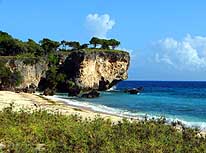
|
-
-
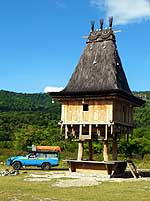
|
-
-
-
-
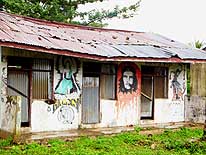
|
-
85
Only two miles before Com –
- at the Eastern end of the road – we
- set up camp again on this lonely beach
|
-
86
This lovely replica of a traditional
- house in Fataluku style, with its thatched
- roof adorned with Nautilus shells, stands
- lonesome on the side of the road on
- the doorsteps to Com
|
-
87
Los Palos is a stronghold of
- the Fretelin-Party. Therefore,
- revolutionary paintings of walls
- are not unusual. Che Guevara seems
- to be the idol in many places anyway
|
-
- Before we hit the road to the mountains the next day, we visit at 8am the “Quality
School International”, where we readily agreed to talk to the children about our
travels. The school is surprisingly small. They have merely 18 children from all ages and
from all around the world: From the United States, Australia, Denmark, Cambodia, Nigeria,
Austria, the Philippines and Timor-Leste. Cindy, the nice American teacher and Jürgen,
the Austrian we met at “Bob’s Rock”-dive site, welcome us. The children are
all happy as we enter their school class. They already had the chance to roam on our
website and are now all exited to meet us personally. We introduce ourselves and tell them
about the countries we visited and the experiences we made. And then, we are ready to
answer their questions. It always astonishes how interesting, how diverse they are. The
planned hour is quickly over, we even add a little extra time. Then the children line up
for an autograph. They were allowed to print out the first page of our website for this
purpose. How glad we are now that this school class is so small. Imagine being in India,
where it’s common to teach hundreds of children at the same time! Before we leave,
everybody poses for a picture in front of our LandCruiser. Then it is time to say
good-bye.
|
-
-
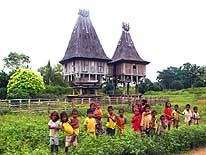
|
-
-
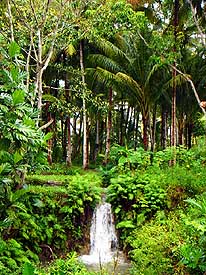
|
-
-
-
-
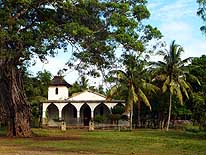
|
-
88
At the junction from Lautem to
- Los Palos and Tutuala, we spot near
- Raça two houses built in the Fataluku
- style, where happy children are eager
- to pose for a picture
|
-
89
At the outskirt of Los
- Palos, we are surprised to
- see this lovely waterfall in
- its tropical surroundings
|
-
90
There are many modest
- churches built in the Portuguese
- colonial style, like here between
- Baucau and Vemasse
|
-
- It is already after 10am, when we leave for the mountains – to the village of
Maubisse, situated on 4’500 ft. altitude 44 miles South of Dili. In many bends, the
road climbs slowly up the hills, revealing at the beginning an impressive panorama down to
the city, the coast with the “Christo Rei”-statue and the island of Ataúro.
Circular thatched houses with conical roofs pop up. They are typical of the Mambai people
and remind us to the African bush. We pass many coffee plantations, protected by a canopy
of giant trees, which provide them vital shade. The higher we get, the more
“homelike” it becomes. Hills covered with pine trees, mountain peaks hiding in
the mist, drizzle and moist and cold weather that make us looking for our sweaters.
Maubisse itself welcomes us with rain and fog. What a big disappointment! Who wants to
camp under these circumstances? We drive to the old Portuguese guesthouse “Pousada
Maubisse”, situated on the hill directly above the town, and ask for a room. Luckily,
we do not have to worry long about the high price [Friday to Sunday it costs $50 (and
today is a Friday!) but during the other days of the week only $16] as it is anyway full
with UN’s and NGO’s escaping the capital’s heat. But at the foot of the
hill in Pension “Bensa An Ama” we get a room for $10. The room is bright, and
there is even a kind of a tiny lounge – a real comfort in this unfriendly climate. We
do not mind that the electricity is working only for a couple of hours and that the bed
cover is too thin to keep us warm during the night. Our own blankets are always readily
available. The following morning, as we draw the curtains, the only thing we see is fog,
mist and fog again. Therefore, there is no need to hurry. Just at that moment, when we
start to make our own breakfast, it’s knocking on the door and breakfast is served:
Freshly baked bread, cheese, butter, marmalade and coffee. Unfortunately, the coffee has
such an awful taste that we prefer to brew new one, with our own water. Then, we enjoy it.
|
-
-
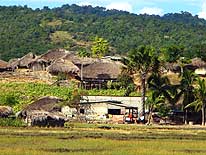
|
-
-
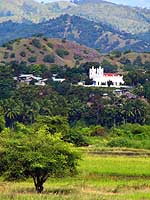
|
-
-
-
-
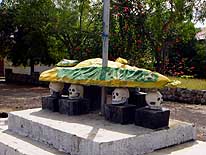
|
-
91
Simple hamlets of thatched houses
- dominate in the interior of Timor-Leste,
- like here between Baucau and Vemasse
|
-
92
The lovely church with its
- two towers in Laleia is situated
- on a hill overlooking the river
|
-
93
These skulls in Laleia are
- supporting the relief of Timor-Leste.
- The monument gives evidence of the
- bloody struggle for independence
|
-
- After breakfast, we are wandering to the market. During the whole stretch we are greeted
by everybody – young or old – with a friendly “Bom Dia” (Portuguese
“Good Day”). Not much does take place there. A couple of elderly women, wrapped
in warm shawls, are sitting in the humidity and penetrating coldness on the floor, chewing
betel nut, which helps them go through the day more easily. In front of them lie the goods
they want to sell: Some oranges, bananas, carrots, salad and sweet potatoes. Two horses
– still an important mean of transport in these mountains with its hard life, where
the hardship is written on the people’s faces – are tied up to a pole, patiently
waiting for their owners to return. Three small children with red cheeks and dirty, shabby
clothes walk barefoot beside their young mother, who carries another child in her arms and
is pregnant again. What life can they expect? Life expectancy is 54 years for women and 52
years for men. Suddenly, the fog is lifting and the sun is blinking through the clouds
– an immediate reason to change the plans and extend our stay for one more day in
this peaceful region. Actually, we are really tempted to penetrate more into the South,
despite of yesterday’s swearing the contrary when we didn’t know how to balance
through the many disastrous parts of the road with enormous deep potholes and sharp edges
of broken tarmac.
|
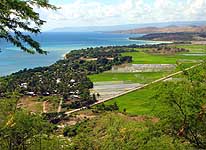
|
-
-
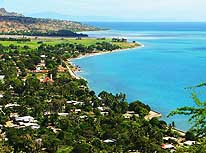
|
-
-
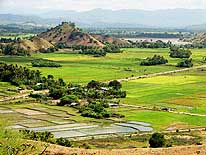
|
- From the pavilion with the statue of the Virgin Mary in Manatuto, we enjoy en
extraordinary view in all directions:
|
-
94
To the rice fields in the East .....
|
-
95
..... to the Coast in the West .....
|
-
96
..... into the hills in the South
|
-
- But as it has happened already before, our longing for the unknown prevails and towards
noon, we hit the road again. Soon after we leave the town, we are already confronted with
the first very bad passage, soon after the second considerably longer one, and then the
third even worse. Exactly that moment when we pull out to discuss whether to continue or
to turn back, a pickup from the GTZ – a German aid organization – comes from the
other direction. This is how we meet Anette and her colleague Georg, both from Germany and
both working in different places in the South for the same organization. When asked about
the road condition further to the South, they both confirm that it’s not getting any
better but much worse. “Even we had to push our car to the limits, and it is
empty”, they add. Therefore, when they spontaneously invite us for lunch back in
Maubisse, we do not have to think twice: We return. While enjoying a simple meal of
noodles and chicken in the restaurant Lena, it’s nice to exchange personal
experiences in various countries with these highly motivated, far traveled people. They
are in Timor-Leste only since a couple of months. Anette’s number of visited
countries already reaches a proud 71, spending her last eight years in the Philippines.
And George was stationed in Cambodia before he was transferred to this difficult place.
The time flies and is too short for all the stories we would like to share. Therefore we
already fix our next appointment: On Sunday at the “Areia Branca”-Beach near
Dili for a “Sundowner”. In the early afternoon, we make another attempt to see
some of the mountain scenery and drive to the nearby viewpoint, only to find out that the
landscape remains hidden in the mist. When drizzle starts additionally, we have enough for
today and seek refuge in our pension.
|
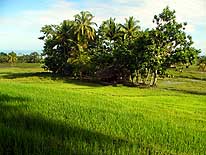
|
-
-
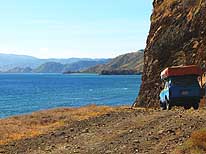
|
-
-
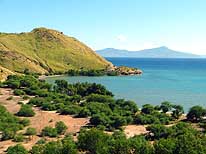
|
-
97
In the middle of a rice field, this
- group of trees and palms offer
- welcome shade to the thatched house
|
-
98
The old street along the rugged
- coast East of the statue of Christo Rei
- was still very adventurous, until it
- was washed away by the sea
|
-
99
Timor-Leste’s small island of
- Ataúro is situated on the Northern
- coast just outside of the capital Dili
|
-
- Nothing has changed the next morning – just another day with fog and rain and rain
and fog again. The young couple from Norway that checked in late last night with the
intention to climb today Mt. Ramelau, with 9’720 ft. the highest mountain on the
island of Timor, resigns and returns to Dili. They hardly have left when the sky clears
up. We hurry up the steep hill to the Pousada, where the scenery is the most spectacular
and enjoy a sweeping view over the rugged mountains with patches of fog roaming around.
Below us lies the village of Maubisse with its lovely white church on a green hill,
reminding us to the Black Forest in Germany. That’s just the time when Dominik
arrives. He is working in Timor-Leste for the “Robert Bosch Foundation”, but
soon will be transferred to Nepal. He is so overwhelmed to see a car with Swiss license
plates in this forgotten place, that he misses the opportunity to take some pictures
during the short moment when the sun adds bright colors to the beautiful landscape. But,
as he tells us, it’s more important for him to have a nice chat with us. Then, we
definitely turn our back to this wet and cold place, eager to return to the warmth and the
sun of the coast.
|
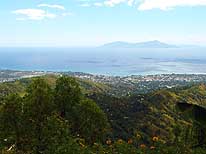
|
-
-
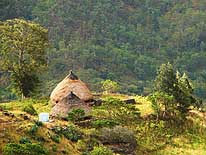
|
-
-
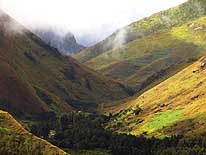
|
-
100
On our way to Maubisse in the
- mountains, we catch a glimpse of
- widespread Dili and the island of Ataúro
|
-
101
The circular houses with
- conical roofs are typical of the
- Mambai people. They are found
- around Maubisse and all the way
- from the mountains to the South Coast
|
-
102
Patches of fog roam through
- the rugged mountains around Maubisse
- – a climate like often in Switzerland!
- We are looking South – behind the
- clouds lies the Timor Sea
|
-
- Once more we retreat to the safe walls of the Backpackers, but not for a long time. The
sunny skies are tempting to be outside. Mid-afternoon, we drive the 2½ miles along the
bay to Cape Fatucama, where at the Eastern end the statue of “Christo Rei”
– a copy of the one in Rio de Janeiro – is on top of a hill. It has been built
at the time of the Indonesian occupation, is 88 ft. (27 m) tall and symbolizes the 27
provinces of Indonesia (by then including East Timor). It was unveiled by Indonesia’s
President Soeharto in 1988, and 1989 it was blessed by Pope John Paul II. But our
destination is the nearby “Areia Branca” beach, which today Sunday is packed
with expatriates and local families, picnicking, grilling, bathing and having a good time
together. Our new GTZ friends didn’t yet arrive, but we don’t remain alone for
long. “Is the blue LandCruiser yours?” a Norwegian guy asks us, who comes along
with two cans of beer. Confirming, a spontaneous invitation follows to join their beach
party. But right at this moment, Anette and Georg arrive. It has been already the third
time today that our good old LandCruiser in its adventurous look opens us doors for new
friendships. For sure, we would not have met Anette and Georg either. In the setting sun,
which casts more silvery strips over the sea than flaming red, we sit on the water’s
edge and talk about our adventures in foreign places. With more than one
“Sundowner”, this lovely evening ends. It is a distinctive evening for us, being
our last one of our three weeks journey in Timor-Leste. Tomorrow, we will head back to
Indonesia. It is already 9.30pm, when we say good-bye, and regardless of all our good
intentions never to drive at night, we have to return through the empty and scarcely lit
streets of the town to the Backpackers. (The Norwegians apparently are working now to
improve the streetlights). A car overtakes us, horning and waving like crazy. We wave
back, but aren’t in the mood to stop, remembering that we are still in troubled Dili.
|
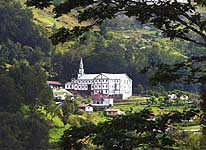
|
-
-
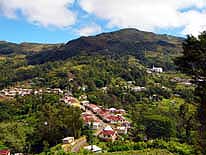
|
-
-
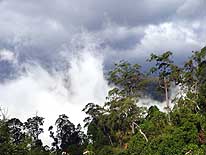
|
-
103
Does the impressive church of
- Maubisse not have a kind of
- Black Forest (Germany) character?
|
-
104
View from the Hotel “Pousada
- de Maubisse” to the center of the
- village and the church of Maubisse
|
-
105
Descending towards Dili,
- the fog is rising higher and higher,
- swallowing up all surroundings
|
-
- We have never been good at bidding farewell. There is always somebody or something that
is not easy to leave behind. Here in Timor-Leste it is especially Ann and Wayne. We spent
many interesting and relaxed hours in their company. They have also been THOSE helpful
people, every traveler dreams to meet in a foreign land. At the Backpackers, it is the
funny parrot we got so fond of. Every time we walked by or fed it with bananas, papaya or
cheese, it called at us excitedly and fluttered around in its small cage; but also
“Bonchi”, the affectionate dog, that every morning was so happy to see us. It is
already mid-morning, when under a blue sky we finally leave westerly towards the
Indonesian border. With full awareness, we take in all the beauties of the untouched
coasts and beaches once more, well knowing that soon we will have to adapt to the opposite
again: Overbuilt and overpopulated Indonesia. Although both of us are positive that we
will make it through the border with the seven months old car paper, issued exactly at the
other end of the archipelago in Kuching/Malaysia, we are a little bit worried. But after
76 miles and 2½ hours of straight driving, we can relax: Exclusive Timor-Leste releases
us friendly, uncomplicated and fast, and well-known West
Timor in Indonesia welcomes us without any problems!
|
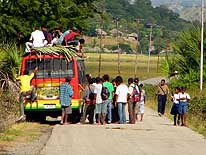
|
-
-
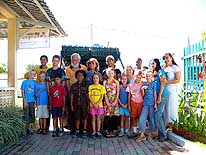
|
-
-
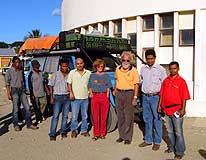
|
-
106
Do all find still a place?
- Bus journeys are always
- adventurous in Timor-Leste.
- Overloading and breakdowns
- happen daily
|
-
107
We visit the “Quality School
- International” in Dili. The children
- of different nations were enthusiastic
- in asking questions. We all had a
- great time!
|
-
108
Courtesy visit at the Directorate
- of Tourism in Dili. The Director of
- Tourism, Senhor Miguel Lobato
- (besides Emil) gives us a warm welcome
- and presents us as a farewell gift the
- beautiful picture book „Timor-Leste –
- Land of Discovery“ from D. J. Groshong
|
|
- Articles in newspapers about us in Timor-Leste:
- Article: "Naran
Hoaktividade", Suara Timor Lorosae - May 31, 2007
- Article: "Prejensa Turista
Suica iha TL", Timor-Post - May 31, 2007
- Internet Blog: "Mad Swiss - Part 2",
Xanana Republic Gazette - May 31, 2007
|
|
![]()





































